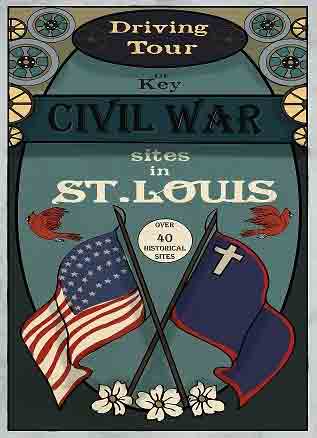
The Gratiot Street Prison Story Piles Horror upon Horror

Dr. Joseph Nash McDowell came to St. Louis in 1840 to start the first big medical college in the west. He was the finest doctor of his day--the finest mad doctor--some say. His lectures amazed and inspired. He charged his own students to attend--which they gladly paid.
In 1847 he built his school at Gratiot and Ninth--a grand structure--with two huge wings around an octagonal tower ringed by a cannon deck--his own personal cemetery. He planned to pickle his family in copper tubes filled with alcohol--after they were dead. But alas, he feared six cannon and more than a thousand muskets could not save his family from desecration. And so he sealed his dead teenage daughter behind an iron door in a cave near Hannibal. She became quite the tourist attraction after naughty boys like Mark Twain pried off the door.
For his wife--she was dead too, McDowell built a tomb on a mound across the Mississippi where he could keep an eye on it with his telescope from the dome atop his tower.
His preoccupation with his dead family females may be ghoulish, but that’s only the beginning. To teach anatomy, the good doctor needed human cadavers, but dissection was against the law. So he taught his students resurrectionism in late, late, late night school--The Fundamentals of Grave Robbing.
When protesters hurled insults and rocks, cannon fire usually sent them packing. If all else failed, he sicked his pet bear on them.
But sometimes, only help from beyond--an angel--or devil--could save the good doctor from lynching. A German girl died of an unusual disease--a fine prize. The doctor couldn’t resist resurrecting her and bringing her to school for show and tell. As he lifted her corpse onto his shoulder to take her to the lecture hall, his lamp went out. He relit it. It went out again. Just then, the shimmering ghost of his mother beckoned him to the window. Below an angry mob stormed the gates.
He raced upstairs to hide the body in the attic rafters, then slipped back to the second floor. In a halo of light his mother’s ghost stood over the very table where the dead girl had been. She pointed his way to his salvation. He climbed up on the table as heavy boots thundered up the stairs.
Men tore sheets off the corpses. The one who pulled up McDowell’s said, “Here is a fellow who died with his boots on. I guess he’s a fresh one.”
“The doctor lay like marble. How he longed to frighten them--to jump up and scare off those superstitious fools. But a soft voice whispered ‘be still, be still.' "
The Germans didn’t find the girl or recognize Doctor McDowell--feel his breathless warmth--hear the throb of life in his veins. Perhaps his devil-angel clouded their eyes and deafened their ears. The good doctor lived to resurrect again.
Dr. Joseph Nash Mcdowell lived an extraordinary life--charmed or cursed depending upon your point of view. After hastening the deaths of thousands of rebs as western Medical Director for the Confederacy, he returned to St. Louis--to find his school turned into the unspeakable horror called the Gratiot Street Prison. Being sent to that prison was a virtual death sentence. Four died every day. A prisoner could be shot just for looking out the window.
He left one room just as he found it--still filled with human gore and excrement. He even added his own diabolical touches--a gallows to hang President Lincoln in perpetual effigy and a statue of Satan with a crocodile at one foot and a rattlesnake at the other. He called the place “Hell.” Doctor McDowell died just three years after the war and now lies at Bellefontaine Cemetery.
The massive building stood empty for 14 years. No one would go near the place. Shadows of dead rebs appeared at the broken windows. But worse than the ghostly shades were the hideous moans and wails of the restless spirits yearning to be free.
The Ralston Purina complex now sprawls where the prison once stood. I hope that a hundred years of making nothing more sinister than dog food and Wheat Chex has purified the place--and released the ghosts.